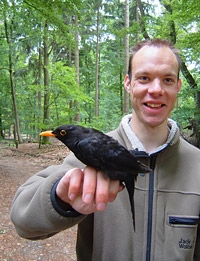
Urbanisation forces blackbirds to evolve
For some time blackbirds have been settling in towns as well as in woods. As a result, town blackbirds have now begun to develop differently from their counterparts in forests. These are the findings of the PhD research carried out by behavioural biologist Erwin Ripmeester who defends his dissertation on 15 December.

Speciation
New species develop when variation takes place between one species and if there is a mechanisation present that ensures that these different groups no longer intermingle. Differences in ecological and sexual characteristics often play a crucial role here. These differences ensure that particular groups develop differently and can also lead to barriers in reproduction between the groups. Too little is still known about the initial steps in speciation. This is one of the reasons biologist Ripmeester focused his research on this phase in the evolution of the species.
Genetic distinction
Ripmeester studied blackbird populations in three different areas in the Netherlands, comparing the birds in the city with their counterparts in a nearby forest. He looked at differences in song, physical build and genetic material. The environment proved to be a determining factor in the song of the male blackbirds, song being their main means of communication. It also appeared that the birds no longer mixed freely with one another, as the town and forest populations are genetically differentiated.
Song
For male blackbirds, song is their prime means of defending their territory and attracting females. They learn their specific type of song by listening to birds of the same species. They have a broad repertoire, and the acoustic structure of parts of their song is easily recognisable. The first part consists of flute-like elements with relatively low tones, directly followed by a second part that is softer and has a higher pitch. The male repeats this song several times, with short pauses between. Ripmeester analysed the song of male blackbirds in the city and the forest and identified a number of noticeable differences.
Warmer
The structure of the songs and the duration of the pauses were shorter in the city than in the forest. This is in the first place a result of the higher density of territorial blackbirds in the city. They therefore have to make greater efforts to ensure they are heard. The season also plays a role. As it is warmer in the city, the breeding season starts earlier and so the city blackbirds exhibit signs of territorial behaviour earlier.
Background noise
The pitch of the songs also varied between the populations. The most probable explanation for this is the difference in background noise experienced by the forest and city populations. The sound in city areas is much stronger particularly in the lower notes. Sounds produced by humans are at the same pitch as the first part of the blackbird songs. Male blackbirds in the city have raised their pitch, which makes it easier to hear them.
Pitch
The difference in pitch is therefore clearly linked to the habitat of the blackbirds. To discover the influence of this on the divergence of the blackbird populations, Ripmeester investigated how the males in both populations reacted to different types of song. The outcome is that city blackbirds are more sensitive to higher tones and song from other city blackbirds. The opposite is true for forest blackbirds. This is an important finding, because it is very possible that this influences the place where males that typically have a city or forest sound want to settle and where they can best defend their territory.
Heavier build
As well as song, Ripmeester also looked at the differences in physical build and genetic material between the two groups of birds. In the areas he studied, a number of significant differences were identified: male blackbirds from the city have a heavier build and also have a shorter beak and shorter legs. Comparison of the DNA showed an unmistakeable difference between the populations. This points to a possible decrease in the genetic exchange betwen city and forest blackbirds.
Nature protection
Ripmeester's research provides fundamental scientific insight into the development of new species, but can also be important for nature protection policy. Understanding the effect of urbanisation on individuals and populations is useful in determining why certain species are able to adapt and others are not. Using this knowledge, a better assessment can be made of what the consequences are of the expansion of urban areas for biodiversity. More effective measures can then be taken in the area of nature protection.
